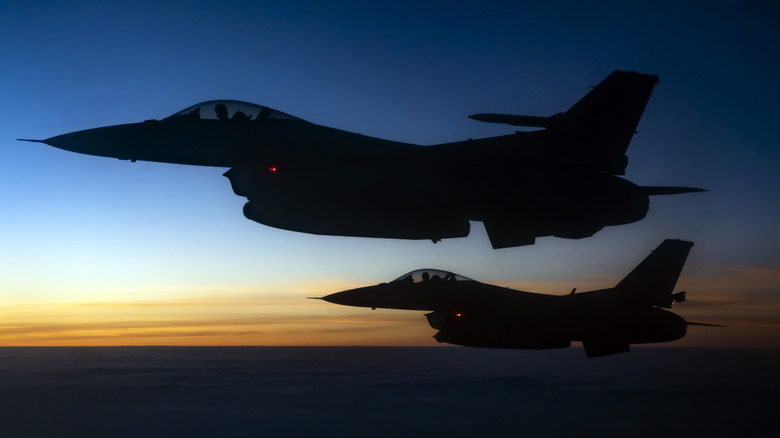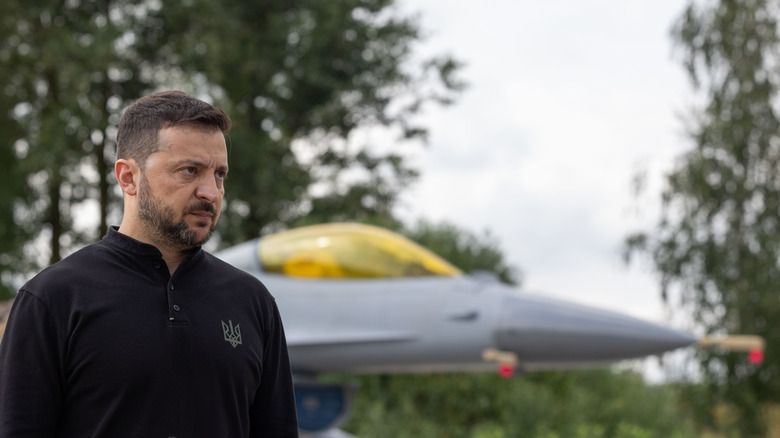Some Countries Are Buying Used Fighter Jets For Their Air Forces, Here's Why
The world is entering a new stage of rearmament, as an influx of geopolitical threats and technological advancements leads to record military spending. In 2024 alone, global defense budgets skyrocketed to over $2.7 trillion, nearly 10% higher than 2023 and constituting the largest single-year jump in military expenditures since the Cold War. While these increases were seen across each continent, Europe saw the largest increase in 2024, accounting for a 17% increase and reaching an astounding 50% nominal rise over the past decade. Traditional heavy spenders like the United States, China, and Russia, meanwhile, continued to escalate their respective spending sprees amid mounting geopolitical challenges.
One sector that is sure to see increasing emphasis is air force spending. As innovations like sixth-generation technology and remote combat capabilities emerge, countries are looking to invest in upgrading their fleets of advanced fighter jets. Despite these investments, most countries lack the capacity to build advanced military jets domestically. For instance, Canada hasn't built a domestic fighter since 1957, while India's Tejas program has struggled to get off the ground.
Instead, most countries are forced to purchase fighter jets from the United States, Russia, France, or Sweden, with China playing an increasingly large role in global sales. But advanced fighters like Lockheed Martin's F-35 come with skyrocketing prices, forcing some potential buyers to search for more cost-effective alternatives. Some countries, like Malaysia, Romania, Argentina, and Greece, have attempted to bridge this gap between need and purchasing power by pursuing secondhand fighter jets.
Why purchase secondhand?
Countries supplement their fleets with secondhand planes because purchasing new, advanced fighters is too expensive, particularly at the scale needed to modernize an air force. Take, for instance, the recent controversy surrounding the F-35, in which Canada, Portugal, Switzerland, and the United Kingdom's acquisition programs have faltered amidst mounting costs. And while much of the controversy harkens to political tensions with the Trump administration, Canada's inability to cut ties with the F-35 showcases the sellers' market that militaries enter when looking to upgrade their fighter jets.
Some countries have tried to reduce their dependence on foreign military imports by instituting their own fighter jet manufacturing programs – to mixed results. Turkey, for instance, has reduced the import penetration of its military from an astounding 80% in 2000, now only importing 20% of its defense needs. A key program in Turkey's military revamp is the lauded KAAN project, which looks to replace a fleet of F-16s with domestically built fifth-generation fighter jets by 2028.
By contrast, India has spent the past 40 years unable to reach the sky-high expectations of its Hal Tejas program, delivering its first jet 22 years behind schedule while failing to produce a fully locally sourced engine. This inability to manufacture a meaningful number of domestic jets is an unmitigated disaster for one of the world's largest air forces. To date, only 31 of the country's 42 sanctioned squadrons are operational, many of which are comprised of aging foreign-made jets set to retire in the coming years.
Thrift shopping
With these difficulties in mind, some cash-strapped militaries have revamped their fleets by purchasing used jets. One example is Malaysia, which confirmed in June 2025 that it would finalize its purchase of 33 used F-18 Hornets from Kuwait, a major step in bolstering its deterrence capabilities. That same month, Romania finalized its purchase of 18 Dutch F-16s in a symbolic €1 sale, one of several purchases by Bucharest to acquire 67 secondhand F-16s from the Netherlands and Portugal since 2013. Another trans-EU agreement saw France deliver 24 Rafale Dassault fighter jets to Greece from 2022 to 2025, twelve of which were secondhand.
Argentina, for its part, received its first used F-16s from Denmark in February 2025, as part of its $300 million deal for 24 of the Lockheed Martin fighters. By contrast, Canada's expected F-35 acquisition costs are nearly $315 million per jet. Indonesia, which abandoned its purchase of Qatari Mirages in 2024, is reportedly considering purchasing used J-10s from China. Croatia, Poland, and Brazil have also discussed secondhand purchases, although no orders were completed. One unsuccessful purchase that readers might find surprising was by the U.S. Navy, which attempted to buy Greece's stock of F-16s for its 'red air' adversary squadrons in 2024.
In recent years, Ukraine has been the ultimate destination for countries looking to offload old fighter jets. Several European allies, including Greece, Norway, Denmark, and the Netherlands, have sent their eastern partner a collective stockpile of nearly 70 retired F-16s in 2024. France has also contributed to Kyiv's fleet, delivering the first of six Mirage 2000s in February 2025. The U.S. has reportedly supported these purchases by delivering non-operational F-16s to use for parts as recently as May 2025.


